Introduction
In a landscape where efficiency and innovation are paramount, Robotic Process Automation (RPA) emerges as a game-changer for organizations striving to enhance operational performance. By automating repetitive tasks across various functions—from finance to customer service—RPA not only reduces costs but also allows teams to redirect their focus toward strategic initiatives that drive growth. As businesses grapple with staffing shortages and the demands of an ever-evolving market, the integration of RPA tools like EMMA RPA and Microsoft Power Automate presents a compelling solution.
This article delves into the transformative benefits of RPA, its diverse applications, and the challenges organizations may face during implementation, offering practical insights for those ready to embrace a more efficient future.
Key Benefits of Robotic Process Automation (RPA)
Robotic Process Automation (RPA) presents several advantages that can transform business operations, particularly through innovative tools like EMMA RPA and Microsoft Power Automate. These solutions specifically address challenges such as task repetition fatigue and staffing shortages, which are prevalent in many enterprises. The advantages of RPA include:
- Cost-Effectiveness: RPA significantly reduces operational costs by automating repetitive tasks, allowing organizations to allocate resources more efficiently.
- Accuracy: Automation reduces human mistakes, resulting in enhanced precision in handling and processing.
- Enhanced Productivity: RPA allows employees to concentrate on higher-value tasks, improving overall productivity and effectiveness in workflows.
For example, a case study demonstrated that a mid-sized company enhanced productivity by automating data entry and software testing, achieving a 70% reduction in data entry mistakes and a 50% speedup in testing processes.
4. Scalability: Organizations can easily scale RPA solutions to meet changing business needs without the need for extensive re-training of staff.
5. Compliance and Audit Trails: Automated processes ensure adherence to regulations and provide detailed audit trails, enhancing transparency and accountability.
The advantages of RPA collectively contribute to improved operational performance and competitiveness in the market, particularly in overcoming outdated systems and enhancing employee morale. The visual representation of RPA solutions further emphasizes their user-friendly nature and the collaborative potential between humans and machines.
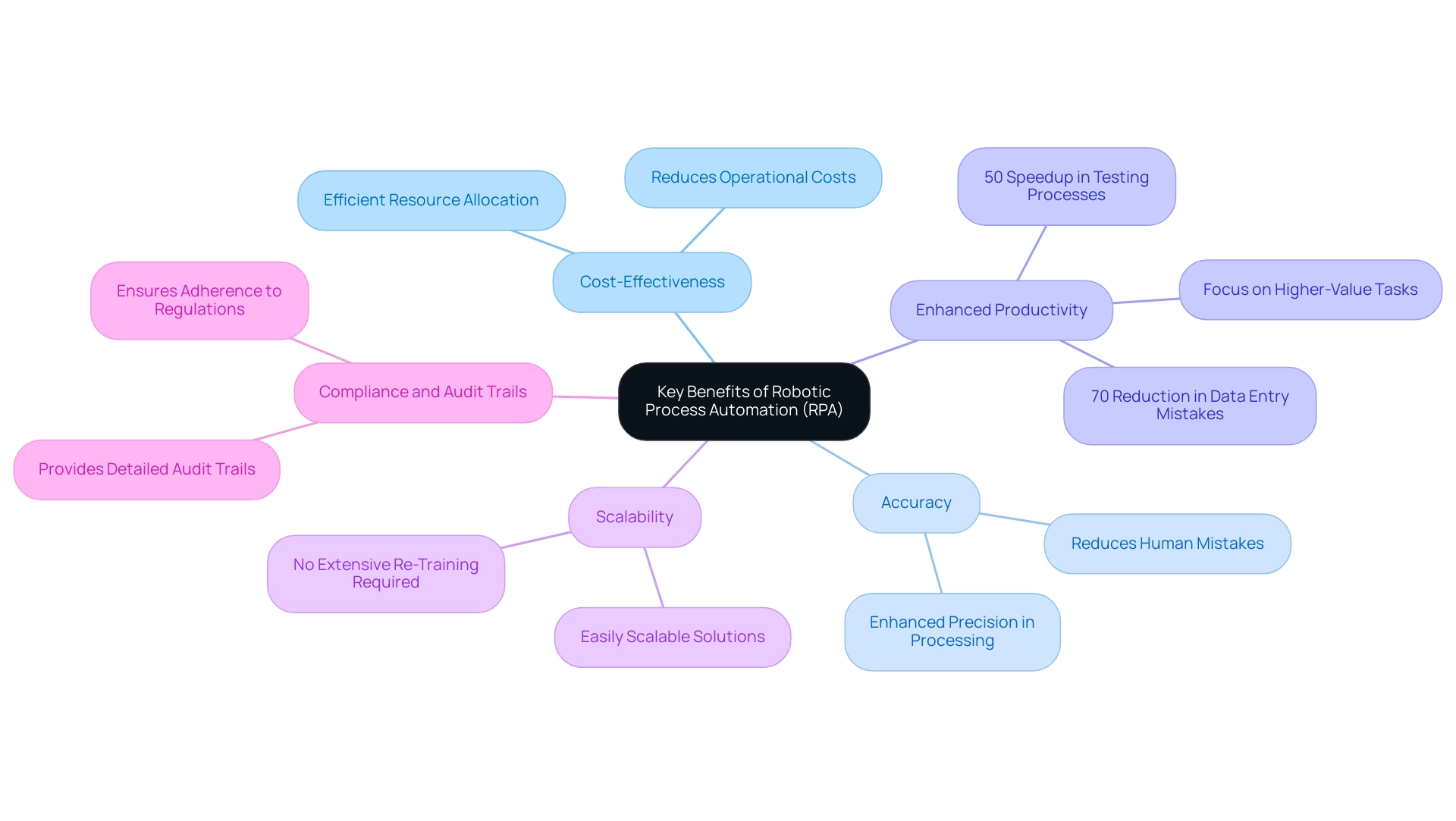
Applications of RPA Across Different Business Functions
RPA can be applied across a variety of business functions, effectively addressing common workplace challenges and enhancing productivity:
- Finance and Accounting: Automating invoicing, reconciliation, and financial reporting processes to reduce errors and save time.
- Human Resources: Streamlining employee onboarding, payroll processing, and benefits administration, helping retain talent by improving employee satisfaction and reducing exhaustion from repetitive tasks.
- Customer Service: Enhancing response times through automated ticketing and inquiry handling, leading to better customer experiences.
- Supply Chain Management: Optimizing order processing, inventory management, and vendor communications to keep operations running smoothly.
- IT Services: Automating routine IT support tasks, such as password resets and system monitoring, freeing up IT staff for more strategic initiatives and modernizing outdated systems.
These applications illustrate the advantages of RPA, as they combat repetitive tasks, improve staffing productivity, and modernize outdated systems, thereby enhancing overall operational performance in a rapidly evolving AI landscape.
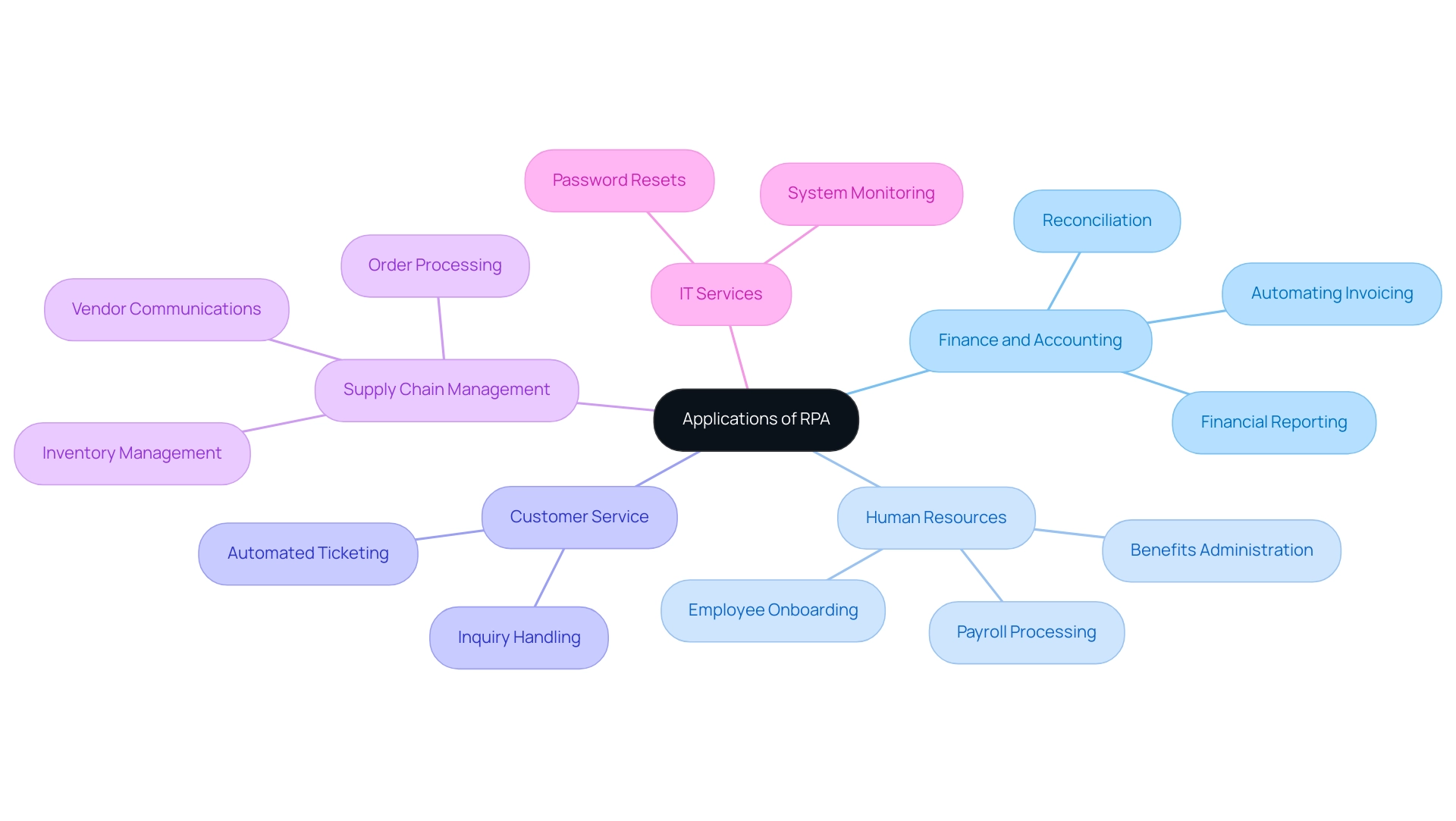
Enhancing Productivity and Customer Satisfaction with RPA
The advantages of RPA include significantly enhancing productivity by automating mundane tasks, which enables employees to focus on strategic initiatives and innovation. For instance, by automating regular data input, your team can focus their efforts on innovative problem-solving, thereby promoting growth and productivity within the entity. Additionally, the advantages of RPA include contributing to cost reduction by minimizing the resources required for manual processes, which allows for better allocation of budgets towards innovation and growth. Moreover, the advantages of RPA also extend to boosting customer satisfaction by ensuring faster response times and consistent service quality.
- Automated systems efficiently process customer requests, minimizing wait times and elevating the overall customer experience.
- Organizations that adopt RPA frequently report notable increases in customer loyalty, attributed to enhanced service delivery and responsiveness.
- To further enhance operational efficiency, integrating tailored AI solutions and Business Intelligence can provide deeper insights and analytics, enabling informed decision-making that leverages the advantages of RPA.
Addressing the challenges of technology implementation, RPA serves as a foundational step towards a more agile and responsive operational framework.
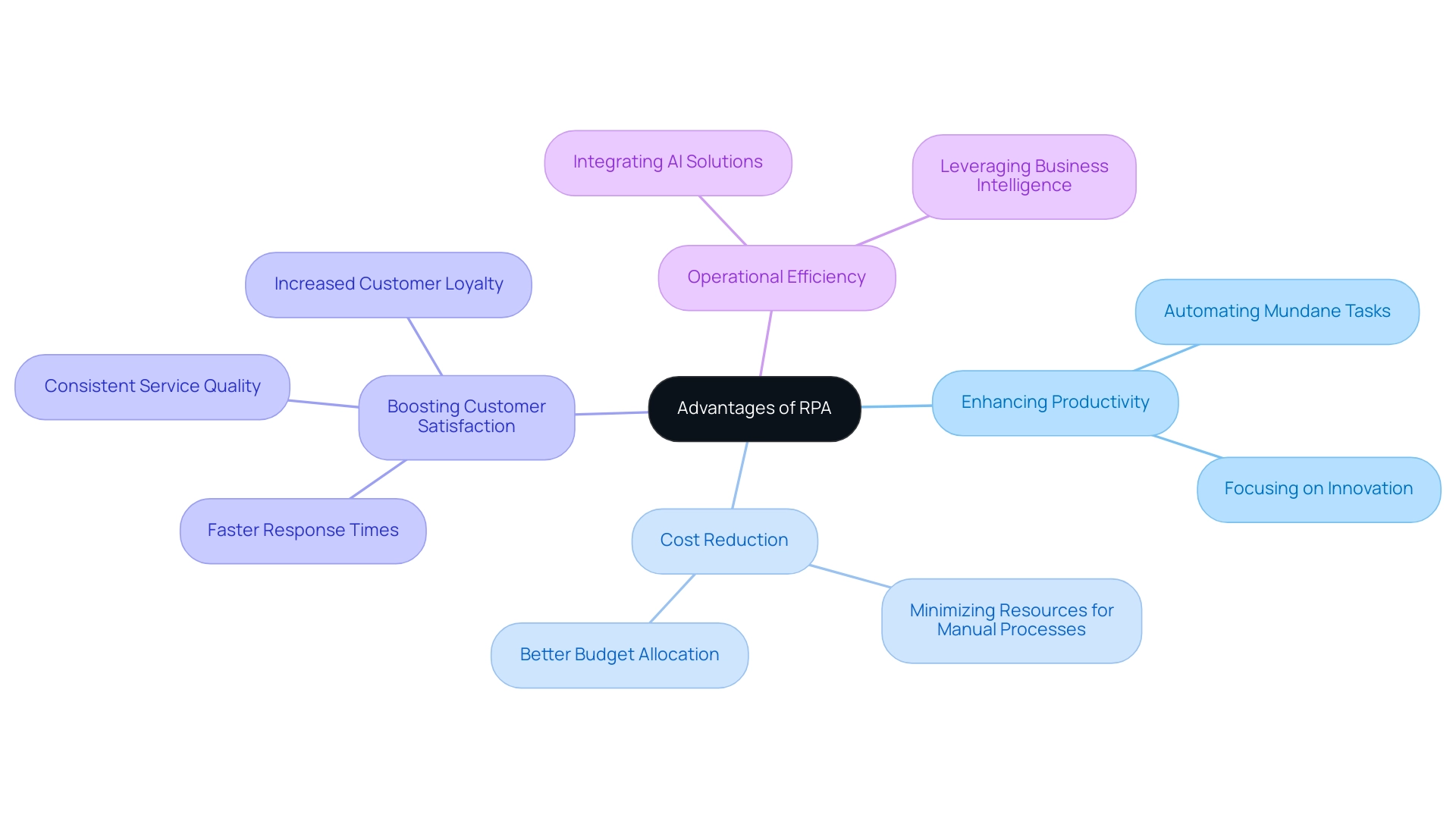
Integration and Analytics: How RPA Streamlines Operations
Robotic Process Automation (RPA) stands out as a powerful tool for integrating with existing systems, allowing organizations to effectively streamline operations across various platforms. AIMultiple informs hundreds of thousands of businesses, including 55% of Fortune 500 companies every month, underscoring the widespread relevance of RPA. By linking disparate systems, RPA reconciles information from multiple sources, ensuring both consistency and accuracy in reporting, which is essential for driving insights based on information.
A powerful advantage of RPA is the advantages of RPA in enhancing analytics capabilities through the automation of data collection and processing. This results in organizations deriving actionable insights more efficiently, empowering informed decision-making and strategic planning. For instance, automated reporting tools can now generate real-time insights, significantly facilitating operational efficiency.
As AIMultiple mentions, while relatively straightforward checks like information type validation can be carried out automatically in databases, more intricate validation that incorporates business rules can be programmed using RPA. This capability means that businesses can implement intricate validation processes, such as monitoring customer usage restrictions based on subscription types, all managed seamlessly by RPA bots. Moreover, RPA enhances treasury management by automating accounts reconciliation and risk forecasting, providing a broader perspective on its capabilities.
In the Telematics case study, RPA enables automated updates and information exchanges in vehicles leveraging Android Automotive OS, resulting in enhanced functionality and security features in automotive applications. Such innovations not only improve operational efficiency but also enrich customer data, ultimately leading to enhanced customer insights and better overall performance. Furthermore, as companies adopt RPA, they often encounter challenges in identifying the right AI solutions that align with their specific needs.
However, by automating repetitive tasks, the advantages of RPA become evident as it frees up teams for more strategic, value-adding work, thereby enhancing employee morale and productivity.
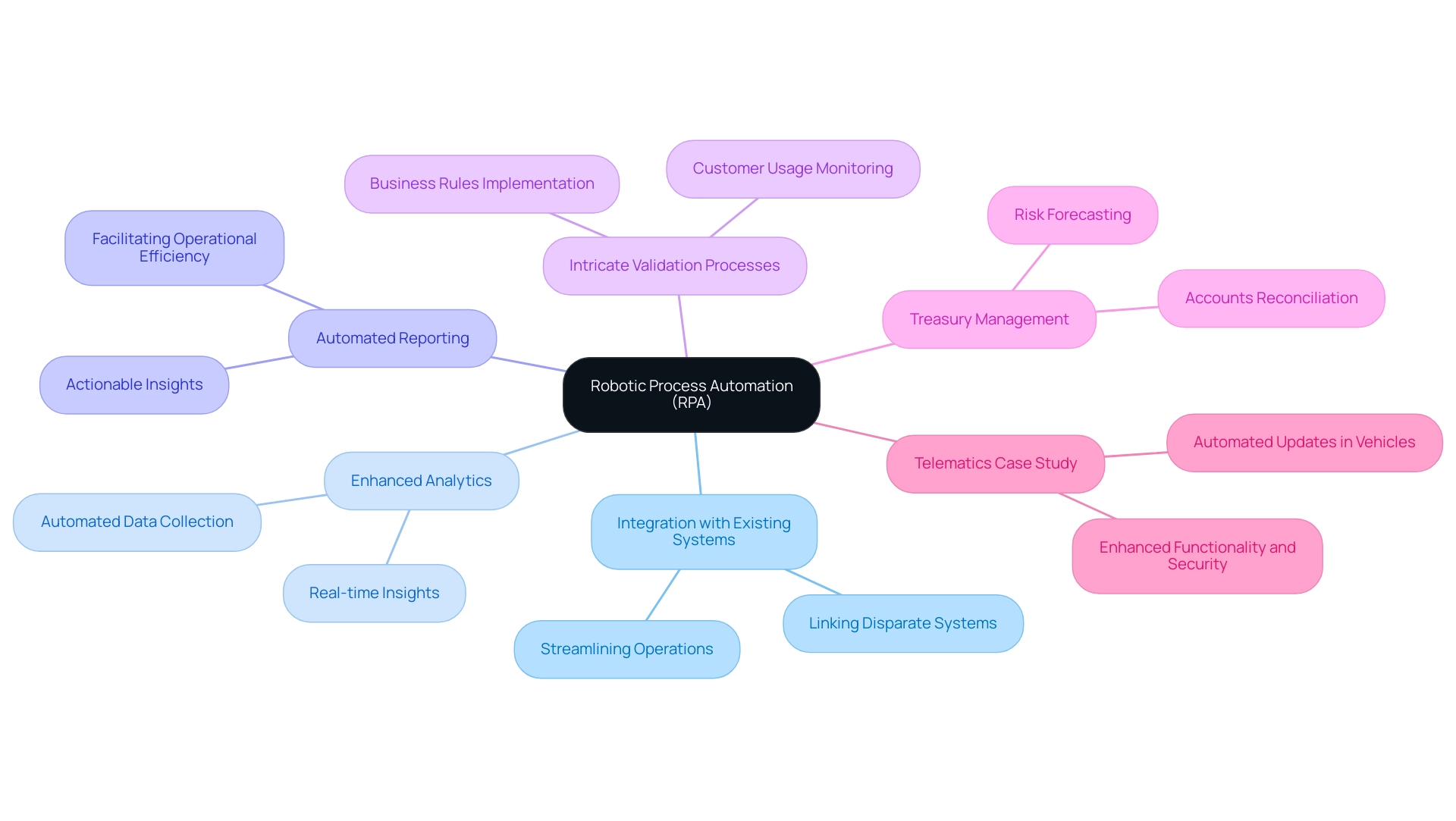
Challenges and Considerations in RPA Implementation
While Robotic Process Automation (RPA) offers substantial benefits for organizations, it is essential to navigate potential challenges during implementation:
- Change Management: Employee resistance can be a significant hurdle to RPA adoption. As highlighted by Minna Mary Saji, a content developer specializing in RPA, effective communication and comprehensive training are vital for fostering acceptance and ensuring team members embrace new systems. This underscores the importance of change management in achieving successful RPA integration.
- Initial Costs: Understanding the costs associated with RPA implementation is critical for optimizing strategy and securing a competitive edge. The upfront investment in RPA technology and training can be significant. Organizations must engage in meticulous budgeting and strategic planning to manage these initial costs effectively. Notably, recent reports in the financial services sector indicate that firms have achieved an 80% reduction in process time after automating data entry, which demonstrates the advantages of RPA and showcases the potential for a clear return on investment.
- Integration Complexity: The technical challenges of ensuring smooth integration between RPA tools and existing systems can be daunting. Prioritizing compatibility assessments and potentially investing in custom solutions is crucial for streamlining this process. A relevant case study, “Beyond the Envelope: Steering Digital Transformation in Postal Services,” illustrates how postal companies are adapting to eCommerce demands while addressing integration challenges.
- Ongoing Maintenance: Maintaining RPA systems requires continuous monitoring and resource allocation to ensure automated processes function correctly and adapt to changes in business operations.
Our approach ensures that you only pay if we deliver the promised results, mitigating the ROI risk associated with automation. By incorporating customized AI solutions with RPA, companies can further improve productivity and informed decision-making.
By proactively addressing these challenges, organizations can not only mitigate risks but also maximize the advantages of RPA, thereby paving the way for successful implementations that enhance efficiency and drive innovation.
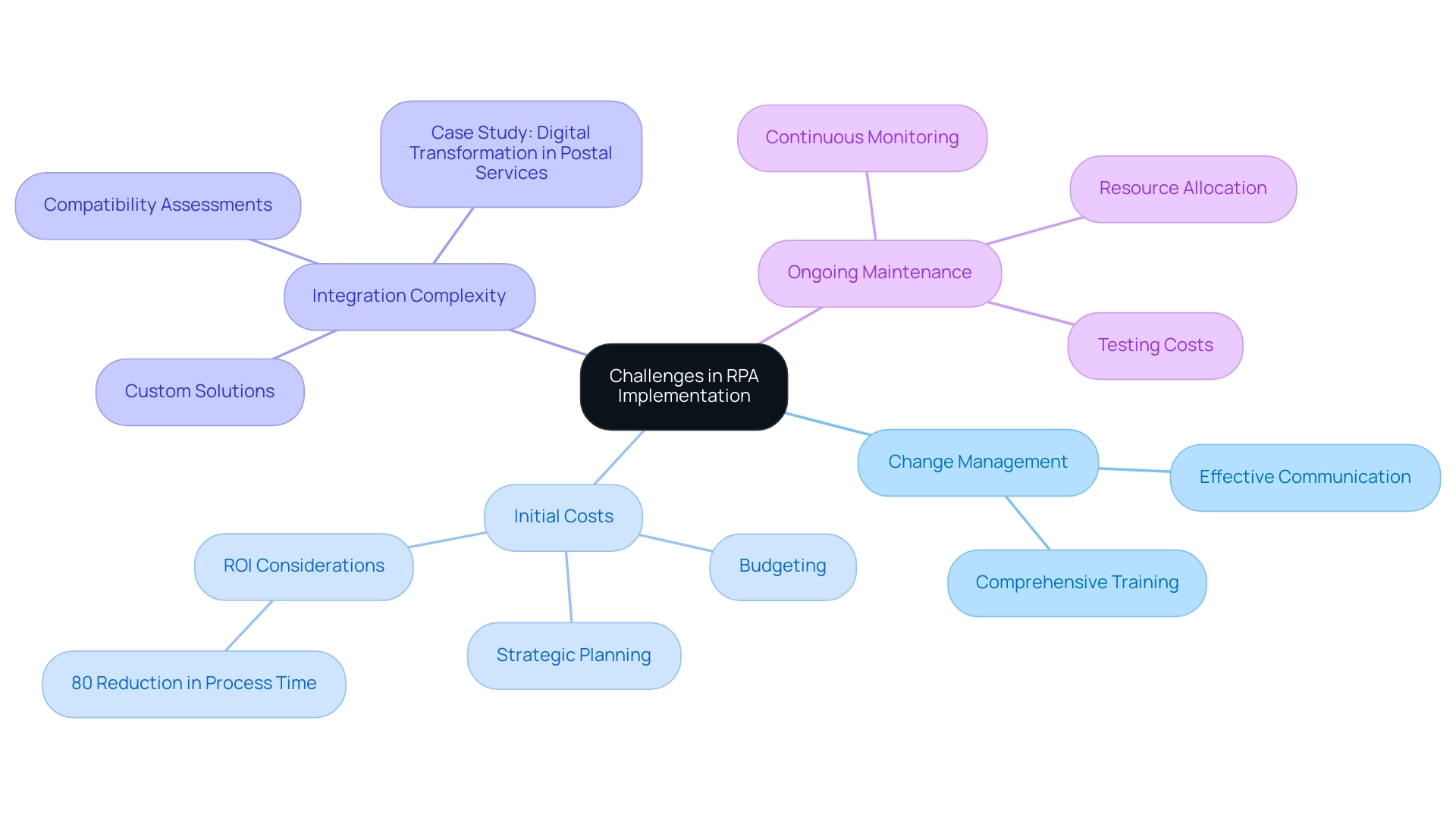
Conclusion
Integrating Robotic Process Automation (RPA) is essential for organizations aiming to boost efficiency and maintain competitiveness. By automating repetitive tasks, RPA provides substantial benefits such as cost savings, enhanced accuracy, and increased productivity, allowing teams to concentrate on strategic initiatives that drive growth.
RPA’s adaptability is showcased across various functions, including finance, human resources, customer service, supply chain management, and IT services. This versatility not only streamlines operations but also improves customer satisfaction and creates a more agile business environment. Furthermore, RPA’s capability to integrate with existing systems enhances data-driven decision-making, amplifying its overall impact.
However, successful implementation of RPA entails overcoming challenges related to change management, initial costs, integration complexities, and ongoing maintenance. Addressing these obstacles is crucial for fully realizing RPA’s benefits and fostering a culture of innovation.
Ultimately, adopting RPA is about transforming operational efficiency and empowering teams to focus on value-added activities. As businesses face staffing shortages and dynamic market demands, RPA emerges as a critical solution, enabling organizations to alleviate the burdens of repetitive tasks and prioritize innovation. Embracing automation is key to achieving operational excellence and creating a more responsive workplace for the future.

